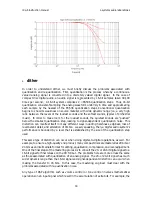
rdq-6 instruction manual
z-systems audio laboratories
17
So far, we’ve only discussed bell-shaped parametric filters. We will now turn our attention to
shelving filters. Whereas bell-shaped filters are used to emphasize or de-emphasize a range of
frequencies in a bell-shaped region about a center frequency, a shelving filter is used to
emphasize or de-emphasize all of the frequencies above or below a desired corner frequency.
A shelving filter is characterized by a pair of parameters: the corner frequency and the gain.
For example, consider the shelving filters shown in Figure 18. These curves correspond to a
low-shelving filter with a corner frequency of 500 Hz and gains of -2 dB, -6 dB, and -12 dB,
respectively. Ideally, a low-shelving filter would be flat until the corner frequency and drop to
a value specified by the gain for all frequencies below the corner frequency. In practice, these
filters have a finite slope, as shown in Figure 18.
The corner frequency is tough to “eyeball” from these plots. Loosely speaking, it is the
frequency at which the magnitude response deviates by 3 dB from the 0-dB reference (which
only makes sense for filters that have shelves lower than -3 dB). For example, the bottom
curve in Figure 18 is down by 3 dB at roughly 500 Hz. Below 500 Hz, the curve continues to
slope downward, approaching flatness at a level of -12 dB. We have not shown a low shelving
filter with boost instead of cut, but this too is permissible.
F
IGURE
18
A high-shelving filter is similar to a low-shelving filter. The only difference is that frequencies
above the corner frequency are boost or cut. Figure 19 shows a family of curves for a high
shelving filter with a corner frequency of 5 kHz.















































